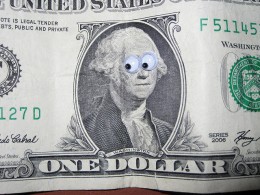Whose Faces Do We Want On Our Currency

“Jeopardy!” champ and public intellectual Arthur Chu makes an impassioned argument for anyone — really, anyone, even Reagan, whom he despises — to replace Andrew Jackson on the $20 bill.
Alexander Hamilton and Ulysses S. Grant were also both deeply flawed men, but I’m not calling for Reagan to boot them off the $10 or the $50 — one helped write the Constitution, the other saved the Union.
No, I want Reagan on the $20 because the man there now, Andrew Jackson, is if not the worst president we’ve ever had (he’s at least in the running alongside Andrew Johnson), definitely the worst president who shows up in lists of the best presidents.
Seriously, having his face on the money cements his place as one of “the greats” among most Americans because most Americans seem to know nothing about the man. There is not a single significant accomplishment of his administration that you can defend today as a positive thing. He was celebrated in the 1830s largely because of the ways in which America was horrible in the 1830s. …
For us to continue to honor a man like Andrew Jackson on our currency while we self-righteously berate our former enemies for refusing to own up to their history is the rankest hypocrisy.
Having been fortunate enough to see a live production of the indie musical Bloody Bloody Andrew Jackson, I have to concur. The larger question is even more interesting, though: how do we decide whose faces should appear on our currency? Who do you want to look at every day when you take out your wallet?
Generally speaking we feature presidents on our bills and coins: Lincoln, Washington, Jefferson, Wilson, Grant. There are a couple of exceptions, notably Hamilton and Franklin. Sometimes we get frisky and print a Sacagawea Dollar Coin and everyone complains about political correctness and also aren’t dollar coins too heavy / too easily confused with quarters? Really we just don’t like change. (GET IT?)
Other countries often do more interesting things with their currency. England had Charles Darwin on one side of the ten-pound note for awhile before elevating Jane Austen. The king or queen lords over the other side of the note.
Japan also honors notable citizens on its currency:
Currently, Noguchi Hideyo (family name is listed first) is on the 1000-yen bank note. In the U.S., our banknotes have pictures of presidents on the obverse sides of the bills. In this case, Noguchi wasn’t a politician, but a prominent, Japanese bacteriologist. Pretty neat, huh?
Who’s on the 5000-yen note?
Currently, Higuchi Ichiyo (again family name first) is on the 5000-yen bank note. Higuchi was renowned for her writing and poetry during the late 1800s. Although Ichiyo is the name that appears on the bank note itself, “Ichiyo” was actually a pen name that Higuchi Natsuko used for her writing.
Who’s on the 10,000-yen note?
Fukuzawa Yukichi is on the 10,000-yen bank note. No, Fukuzawa wasn’t a Japanese politician either. Yukichi was a number of things, a writer, a translator, and a businessman, among other things. However his most well-known accomplishment was the founding on Keio University, which is located in Tokyo.
We could do this! We could boot Jackson and replace him with someone besides Reagan, someone exciting, someone who contributed worthwhile and positive things to this nation and/or the world. Oprah, maybe! Jonas Salk! Emma Goldman! Let’s have a coin with John Brown on one side and MLK on the other. Now that would be something.
Take your pick and/or make your suggestions in the comments.
NEPOTISM NOTE: Chu and I went to college together but only knew of each other, if that. Still, I’m enjoying watching him rise in prominence.
Support The Billfold
The Billfold continues to exist thanks to support from our readers. Help us continue to do our work by making a monthly pledge on Patreon or a one-time-only contribution through PayPal.
Comments